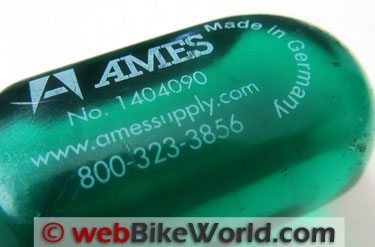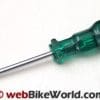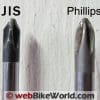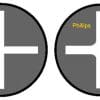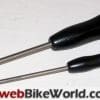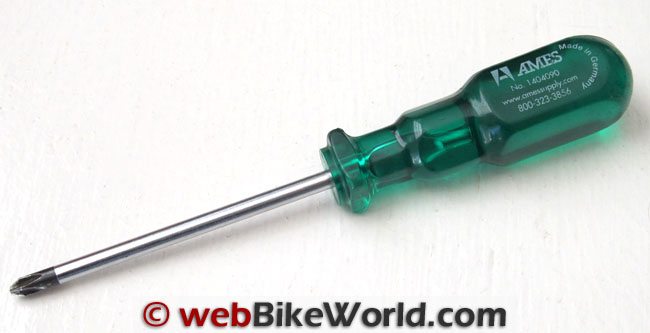JIS screws: Myth or Miracle?
That is often the question when it comes to discussing JIS or Japanese Industrial Standard screwdrivers.
I’ve been told there is no difference between a standard Phillips (or “cross-head”) screwdriver and a JIS screwdriver, as long as the sizes are equal.
I wasn’t so sure.
And my co-writer, Johnny, received strong push-back at a local motorcycle dealer for even suggesting such a screwdriver existed!
But more on that in moment…
I first found out about JIS screwdrivers through some website years ago, but I didn’t think much about it until I went to change the coolant on my girlfriend’s Honda NX250.
The lock screw on the radiator cap is rather small and my standard screwdrivers were cutting it up like a fine French cheese.
Johnny then came to the rescue with his “wonder” screwdriver (hmm — that sounds kind of odd!).
Anyway, even though the screwdriver itself looked about two sizes too large, it fit perfectly and it cleanly bit into the screw even after I had tortured the poor fastener with my standard array of screwdrivers in various sizes.
He was definitely on to something. Here he is to tell his story.
The parts guy at the motorcycle shop stared at me for an eternity before he finally blinked and said “There’s no such thing.”
Patiently I tried again to explain to him just exactly what I was looking for: A Japanese-spec screwdriver that wouldn’t strip out the screws on my old KZ 650.
I suggested he ask the mechanics in the shop, figuring they would probably know where I could get one.
But that didn’t work out either. He returned a few minutes later, only to tell me that the mechanic said I was using the wrong size screwdriver.
About JIS Screwdrivers
Sigh…I’ll try again for you, dear reader, to explain.
Largely unheard of outside of Japan, the JIS cross-head screw can be a real pain in the neck.
Back when everyone was trying to standardize fasteners, the Japanese were no exception.
They got the standard inclined plane right, but no one really got together on the head design, so the Japanese cross-head is slightly different.
The JIS screws are usually — but not always — identified by an upraised or recessed dot on the head, or the fact that they are completely gored out and will only come off with a set of Vise-Grips.
The difference is the walls of the slots in the JIS screw head, which are parallel and which will cause the regular style Phillips screwdriver to cam out of the screw as you’re trying to turn it.
The “corners” at the center of a Phillips head screw have a slight radius, supposedly designed to allow the Phillips head screwdriver to cam out as a sign that maximum torque had been reached.
Also, the JIS screw head slots have a shallower depth, preventing the taller head design of a Phillips head screwdriver to properly grip the sides of the fastener .
Now, back to the story…
I left the motorcycle shop and decided to shop the internet for some JIS screwdrivers.
The screws in question were pretty well buggered up. I had been stripping them out for a couple of years already with an expensive Snap-On screwdriver, so I anticipated taking them off with vise-grips and putting hex head screws back in.
Wouldn’t look right, but it would hold my points cover on.
After searching for “JIS screwdrivers”, I came up with an outfit called Ames Supply.
Up to that point, I had found mostly the small handled and tipped JIS screwdrivers that are so commonly used in electronics repair.
I was looking for something a little more beefy, and I found it in the Ames Professional Green Handle line, part # 1404090.
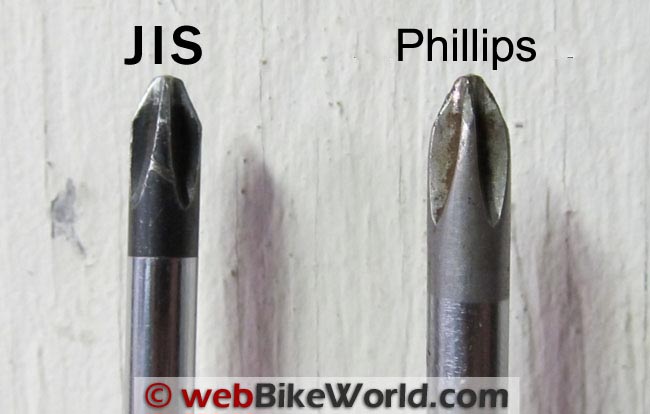
JIS Screwdriver Notes
JIS screwdrivers are available from sizes 000 to 0 (very small, precision-type screwdrivers for electronics) to 1 and 2 (more useful for motorcycles).
Note that a JIS screwdriver will usually work on both a Phillips head and JIS screw, while a Phillips head will usually work only on a Phillips head screw.
JIS screwdrivers can be difficult to find; here’s a nice selection through the Amazon.com webBikeWorld affiliate link.
A #1 and #2 size are probably the most useful types for motorcycles.
It has a large beefy handle that is easy to grip and a squared portion that you could actually use a wrench on if you needed to. I never have though, so I can’t attest to how durable that part of the handle is.
Brandon was trying to remove a smaller JIS screw on a Honda dual sport (mentioned earlier) and his regular tools were stripping the screw head.
I told him all about my “wonder screwdriver”, and he encouraged me to try it out. It worked like a charm, and now he owns four JIS screwdrivers.
Unfortunately, the Ames # 1404090 is no longer listed (Ames is no longer in business as of February 2013).
They still have several other options though that should do the trick (and here’s a selection of JIS screwdrivers at Amazon.com.
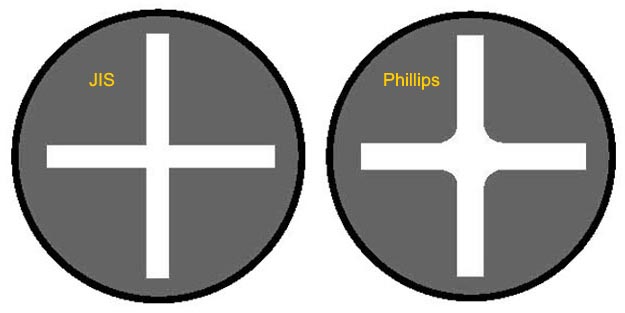
The Ames Supply JIS Screwdriver
I really like this screwdriver. It actually works great on the JIS screws that I have previously stripped out with regular tools.
(Brandon) I did order a set of four screwdrivers and they are the electrical/hobby type tools Johnny mentioned earlier.
I went for these as opposed to the Ames because it was a complete set of four sizes the largest of which is nearly the same size as the Ames tool we’ve used for this review.
The only problem I have run into with these tools is that they indeed do have a rounded, smooth handle which is less than ideal for getting stick screws out, as grip is limited (photo below).
On the plus side, the smaller sizes included are excellent for working on other electronic devices, both motorcycle related and not.
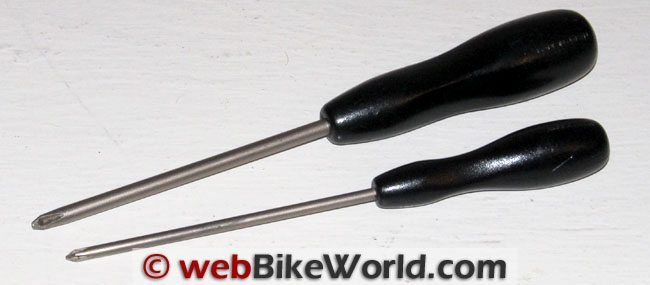
JIS Screwdrivers: The Test
When Johnny first brought over his JIS screwdriver to work on the Honda radiator cap screw I didn’t even think about capturing it on video or taking photos.
Little did I know that we would have wanted to record that event for this article some time later.
Since that bike was now gone, we needed a new test mule and fortunately I recently acquired a 1978 Suzuki GS550E with plenty of very old and very Japanese screws on it.
This should have been a slam dunk for us to find a screw that the JIS screwdriver would break loose with authority while the Snap-On would spin uselessly, leaving a cloud of metal shavings in its wake.
Well, it wasn’t as easy as we thought to get that result.
Most of the screws on the GS550 seemed to not care which driver was used and the Snap-On answered every challenge as easily as the green handled “wonder” screwdriver.]
We were rather puzzled. Had we been fooled somehow? Were we going to have to admit we were wrong and had imagined the previous experience altogether? Something was going on.
Thinking about the previous “miracle” the JIS screwdriver had performed on the Honda NX250, we both recalled the screw in question was rather small (as mentioned earlier).
On the petcock of the GS550’s fuel tank was a pair of small screws with shallow heads. Sure enough, the Snap-On had met its match. The orange handled screwdriver was unable to bite into the screw head and slipped right out.
The JIS screwdriver, however, was able to get a solid bite and was able to easily turn the difficult fastener. You can see the results in the video below.
Conclusion
JIS screwdrivers are definitely different from the standard Phillips head type, although the differences in actual performance can vary depending on the fastener in question.
With many of the large screws on the GS550 engine, neither screwdriver had an advantage. The small and shallow screws are the places where the JIS screwdriver shined in our test.
I would still recommend having one of these screwdrivers in your tool collection if you work on Japanese products.
Even if the screw heads on your current machine are in perfect shape, using a JIS cross-head screwdriver on them can help reduce damage when the time comes for repair.
More Information on Screw Types
More information can be found here: List of Screw Drives (Wikipedia) | Bolt and Screw Head Types | Fastener Type Chart.
Also see the wBW Nuts, Bolts and Motorcycle Fasteners Page.
More webBikeWorld:
▪ Motorcycle Tool Reviews
▪ Vessel JIS Motorcycle Screwdriver Kit Review
▪ Hozan JIS Screwdriver Review
| wBW Review: JIS Screwdrivers | |
|---|---|
| Buy Your JIS Screwdrivers at Amazon.com! | |
| Manufacturer: Ames Supply (As of Feb. 2013, apparently no longer in business) | List Price: Approx. $4.00 to $15.00 each. |
| Color: Green. | Made In: The Ames JIS screwdriver is made in Germany. |
| Review Date: October 2011 | |
Owner Comments and Feedback
See details on submitting comments.
From “M.” (March 2013): “Some (many?) modern Triumphs use Japanese made controls with JIS screws. I had a ‘Eureka’ moment when I read about these recently. I always wondered why my control screws were slowly stripping out (hey, they screw into plastic — how soft are these things?) and working on Japanese carb float bowls always led to at least a couple being replaced after using Vise Grips on them.”
From “P.B.” (August 2012): “McMaster Carr handles JIS screwdrivers made in the U.S.A. Also RJR Cool Tools”
From “W” (October 2011): “I heard about the JIS “legend” a few years ago on a couple of different motorcycle forums. I inquired about these when I would find myself at a new bike dealership or hobby shop. Nobody had heard of them.
The parts manager at one Yamaha dealership started getting angry at me.
He took me to the showroom to demand evidence for this line of (bull) I was trying to feed him. I pointed out the “dot on the cross” on screw heads of every bike we looked at.
His anger dissipated and he said “You know, I sell way too many replacements for stripped screws. If you find one of these screwdrivers, bring it by.”
Last year, I received a package from England with a display stand for Dunhill pipes. It required minimal assembly, but there was a screwdriver in the box.
I wondered why, then looked at the screw heads and saw the “dot on the cross”.
One of my employees was present and quite concerned to see his normally reserved boss giddy with excitement over a screwdriver.
Aside from changing the handlebar on a Suzuki with no drama or cursing, owning this screwdriver has not changed my life.
Most fasteners that require any serious torque are hex nuts or bolts, but I do feel better having this in the tool box.
P.S. The screwdriver I received from England has a blue plastic handle marked City 8151. I looked at the tip and the blades do not taper. Ironically, the City logo is a unicorn.”
From “B.P.” (October 2011): “Regarding the JIS screwdrivers, I first noticed this when working on my 2000 Valkyrie Interstate about a dozen years ago.
I used to change the brake and clutch fluid annually, and quickly buggered the reservoir screw heads.
I wrote an article back then about installing and using SpeedBleeders for the Valkyrie community, which I put up as a page on my website.
In that article, I included a caveat about not using plain ol’ Phillips screwdrivers, as I had managed to bugger the heads of the reservoir-cover screws doing that.
In 2007, I sold the Valk and bought a Burgman 650 Exec. In 2008, I wrote a long post in the “How To” section of BurgmanUSA.com, the main US web forum for Burgman owners, just to share my knowledge with this new-to-me community.
Like your experience with the parts guy, et al., I met a lot of resistance; and, hey, that’s OK in a sense, as I was not looking for disciples, I was just sharing information, take it or leave it.
Eventually, about a month after that post, I made a 500-mile detour on a ride I was taking.
I had in the cavernous Burger underseat storage a collection of screwdrivers, including high quality Klein Phillips #1 and #2, and similarly numbered JIS screwdrivers.
I stopped off at one of the top posters at BurgmanUSA and creator of “The Burgman KnowledgeBase“, and let him try the screwdrivers on his own reservoir screws.
He came away a believer: see the post, a little more than half-way down that thread page, “by Colchicine » Wed Apr 30, 2008 9:44 09”.
So, been there, done that. Incidentally, a good info resource on this subject is, IMHO, thisInstructables page; that page was the basis for the (minimal) comments on JIS screw heads at Wikipedia.”
From “P.S.” (October 2011): “Good to see that you’ve added a link to the Amazon Store for the JIS screwdrivers since Ames has a $50 minimum order requirement.
They first accepted my $15 order, then quickly realized their error and canceled it. Politely, of course, but my order was still canceled. $50 would buy a lot of screwdrivers.”
From “J.W.” (October 2011): “Reed and Prince (screwdrivers) were a big problem in the early days, 60’s and 70’s, because most home tool boxes had those versus the Philips.
Reed and Prince were designed for wood screws while Philips were set up for machine screws.
Many screw heads on Japanese machines were destroyed by Reed and Prince screw drivers. Hold them up to a Philips and you will see the angle is sharper then the Philips.
A good quality Philips screw driver will handle most screws.
What was done back in the day for the exceptions was to use a manual impact driver. You set it with a twist and then hit it with a hammer and it drives out the screws.
For most screws a sharp tap with a light hammer will get them started out. They are still available and work wonders on these old bikes. Yes you can pop the head off a really stuck screw but you wouldn’t have got it out anyway.”
From “C.H.” (October 2011): “Not sure if you mentioned this in your article or not but a common solution to the “American” Phillips vs. “Japanese” Phillips screw driver problem is to simply grind down the very tip of an ordinary set of Phillips screwdrivers in all sizes.
This mod will allow the regular Phillips head to seat all the way down into the head of the Japanese screws and get a better “bite”. It may not be a perfect solution as opposed to a genuine J.I.S. screwdriver but it has worked great for me.”
From “J.T.K.” (October 2011): “Great article as usual but it hardly ends there. There is also Pozidriv, used largely on British machinery, identified by a much smaller cross 45 degrees from the main cross and Prince and Reed which likes a sharper version of the common Phillips.
New drive types appear all the time causing confusion for service technicians and income for the tool companies. Go figure.”
Editor’s Reply: I did a quick check and found some very interesting drive types besides the common hex, Allen, slotted and Phillips.
They include (in alphabetical order):
Bristol; Clutch Head; Double hex; Frearson; One Way; Pentalobular; Phillips tamper-resistant; Polydrive; Pozidriv (aka SupaDriv); Quadrex; Security hex socket (pin-in-hex-socket); Spanner (“snake eyes” and “notched”); Spline drive; Square; Robertson (square); Square Recess, Square Recess Tamper-resistant; Torx; Torq-set; Tamper-resistant Torx; Torx Plus; Tamper-resistant Torx Plus; Tamper-resistant Hex; Tri-Wing; Triple square.
Anyone know of any others?”
From “D.T.” (October 2011): “I just read your JIS screwdriver article. Interesting (although I have no Japanese motorcycles, I will be careful taking out screws on Japanese electronics items now).
You should consider doing a review of the Picquic Screwdrivers. The only multi-bit screwdriver I will now use.”


